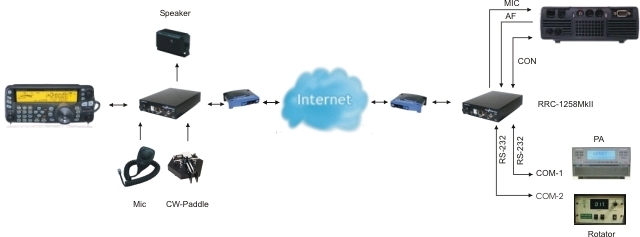| The Remoterig RRC-1258MkII is developed specially for remote control of Amateur radio stations via the Internet, in and user friendly and cost-effective way. The Remoterig units are normally used in pairs, one is connected to the radio and the other is connected to the control equipment. The system is unique in the way that no PC is needed, both voice and data communication is handled by the two units. RRC-1258MkII can be configured to work together with most Amateur radio stations available on the market from ICOM, Kenwood, Yaesu and Elecraft. The Remoterig system fits very well in the following situations:
– You are not allowed to put up antennas at your home. – The noise level is to high to make Amateur radio activity possible. – You want to build so big antennas that can’t be done in urban areas. – You do not want to be dependent of PC:s for the remote control. – Etc. |
– It’s a stand alone system Supports – ICOM |
|
|
Functionality You will get the ultimate function of the Remoterig system together with radio stations with detachable control panels like Kenwood TS-480, TS-2000 or ICOM IC-706 and others. You simply replace the cable between the control panel and the radio with the Remoterig system. You will get the same feeling and functionality as with the original setup. The system also works very well for more traditional remote control from PC-based control softwares like HamRadioDeLuxe etc. The Remoterig boxes solves the voice and data problems but you need a PC for the Control software it self in this setup. The RRC-1258MkII is based on a embedded system with a powerful ARM7 CPU from NXP. The system will be totally independent, and with no PC.s involved the system will be extremely reliably. The Remoterig system it self will not introduce any noticable latencies and the latencies introduced by Internet will rarely be any noticeable problem. The Remoterig system also includes a unique solution for operating CW over Internet, with among other things a built in CW-keyer. The Remoterig system is connected to the Internet primarily via 10 or 100Mbit Ethernet and fixed connections like DSL, Cable and WLAN. 3G based mobile solutions will also work, sometimes with reduced performance. The system is portable and you can use it from almost any network connection in the world. Session initiation, audio (VoIP) and data is transferred using standardized protocols like SIP, RTP etc. where you can select different audio qualities depending on available bandwidth. The RRC-1258MkII is easily configured via modern USB and WEB based user interfaces. |

The Remoterig systems is based on well known and existing VoIP technology. The connection established between the control end and the radio end uses world-standard SIP protocol. SIP is well known in internet telephony, telephone operators offer these days SIP-phones to replace old POTS telephones. The connection between the remoterig boxes can be considered as an internet telephone call where the control end is the calling party and the radio end is the called party which automatically accepts the call.
Remoterig boxes are built around a reliable and simple microprocessor technology, which interface to Ethernet networking, serial input/output for serial ports and audio channels for transmit/receive audio. Design is reliable so that it can be leaved to a remote site without worries will the box answer or not.
Networkwize the boxes communicate with each other in several parallel data streams. Audio traffic and control traffic have their own UDP data streams amongst the SIP traffic which maintains the connection. The boxes feature also web and telnet servers for configuration.
Audio coding in Remoterig features low latency as there is really no processing power available to do compressed audio coding which would add audio coding/decoding but save network bandwidth. Several audio quality levels are available, even for low network speeds. Better audio quality means of course more network bandwidth, and highest quality consumes over 300kbit/s network bandwidth but offers very good dynamics, well over what average radio can output to the audio stage! The later version of Remoterig devices feature also dual audio channels, where a stereo codec is used to pass two independent audio channels to deliver both main and auxiliary receiver audio to the control end.
Remoterig features three serial ports which are tied together with the corresponding ports on the other end over IP network, serial port traffic flows multiplexed in the control data stream amongst PTT and CW information. Usually the first serial port (com0) is used to pass control head data traffic between the remote radio and the control head, and the two remaining ports can be used for other serial port applications, eg. CAT or rotator control.
Remoterig functions well over firewalls and NAT technologies. NAT is used widely in internet traffic, by home networking devices (broadband routers etc.) or by internet service providers to control the . NAT provides a simple protection for home networking so that all outbound internet traffic from multiple machines looks like originating from a single address, which the broadband router has assigned. The router takes care of directing the inbound return traffic from internet to the right host, which originated the outbound traffic originally. Remoterig session is always established by the control end, which creates all of the connections to the remote end and therefore work through firewalls & NAT’s with usual configuration.
The radio end does work with NAT technology also, but requires so called port forwardings to be configured to the firewall or router so that the radio host is reachable by SIP and audio and control connections can be established. Remoterig is also capable of announcing the IP address which it is assigned to via a Dynamic DNS service, making it reachable even with a dynamic IP address which changes periodically. Remoterig supports ‘DynDNS’ dynamic DNS service. Today the Remoterig system supports the ‘conventional’ IPv4 IP-addresses, the firmware will also support IPv6 in future software versions.
